Georgia is one of the states with a high number of frogs in the Southeastern parts of the United States.
It shares some species with Florida while it has some species Florida doesn’t have as there are no Cane Toads here.
Frogs and toads of Georgia are mostly found in the Eastern parts of the state.
Coastal regions and wooded regions in coastal regions offer ideal habitats for the species.
Most frogs in Georgia are active until mid-fall preferring to overwinter afterward. Some species move inland to overwinter while others may even overwinter in caves.
Table of Contents
Are There Poisonous Frogs and Toads in Georgia?
Most frogs and toads in Georgia can cause some irritation. Only Pickerel Frogs are truly poisonous, on the other hand.
These are frogs that use skin secretions to keep predators away. These frogs keep the species safe in front of snakes and mammals.
Humans might also experience skin-level reactions such as minor rashes when handling these types of frogs.
Some people can also show other mild reactions such as irritated eyes.
Toads in the state aren’t poisonous. They can eat poisonous species but they aren’t poisonous themselves.
32 Frogs and Toads in Georgia
There are 32 species of frogs and toads in Georgia. Only one Pickerel Frogs are poisonous out of all of these native species.
1. Green Treefrog

Some of the most common species in Georgia are Green Treefrogs (Hyla cinerea).
This species is known for its aggressiveness as well.
It shows aggressive behavior between males which it controls through calls. Green Treefrogs are also known to flee when seeing humans.
Green Treefrogs are a common sight during the mating season when males call for females.
Male Green Treefrogs can also fight or wrestle each other.
The call of the Green Treefrog has been compared to the sound of a bell. This call is repeated at least 50 times per minute during the mating season.
Green Treefrogs are known predators of mosquitoes and flies. They also eat small spiders.
2. Cope’s Gray Treefrog

A very fast-paced repetitive call is specific to Cope’s Gray Treefrogs (Hyla chrysoscelis).
The fast-trilling call of the species is heard in the summer, during the mating season.
May marks the start of Cope’s Gray Treefrog mating season. This mating season lasts until August.
This is also the time males are heard calling but they may also call during bad weather.
Cope’s Gray Treefrogs prefer low-elevation woodlands and low-elevation humid habitats.
You can identify the species by its gray-to-white coloring and its yellow or orange inner hind legs.
A green morph is also specific to Cope’s Gray Treefrogs. These types of frogs have a light green nuance with warty skin.
Moths are among the common food preferences of this small species.
3. Squirrel Treefrog
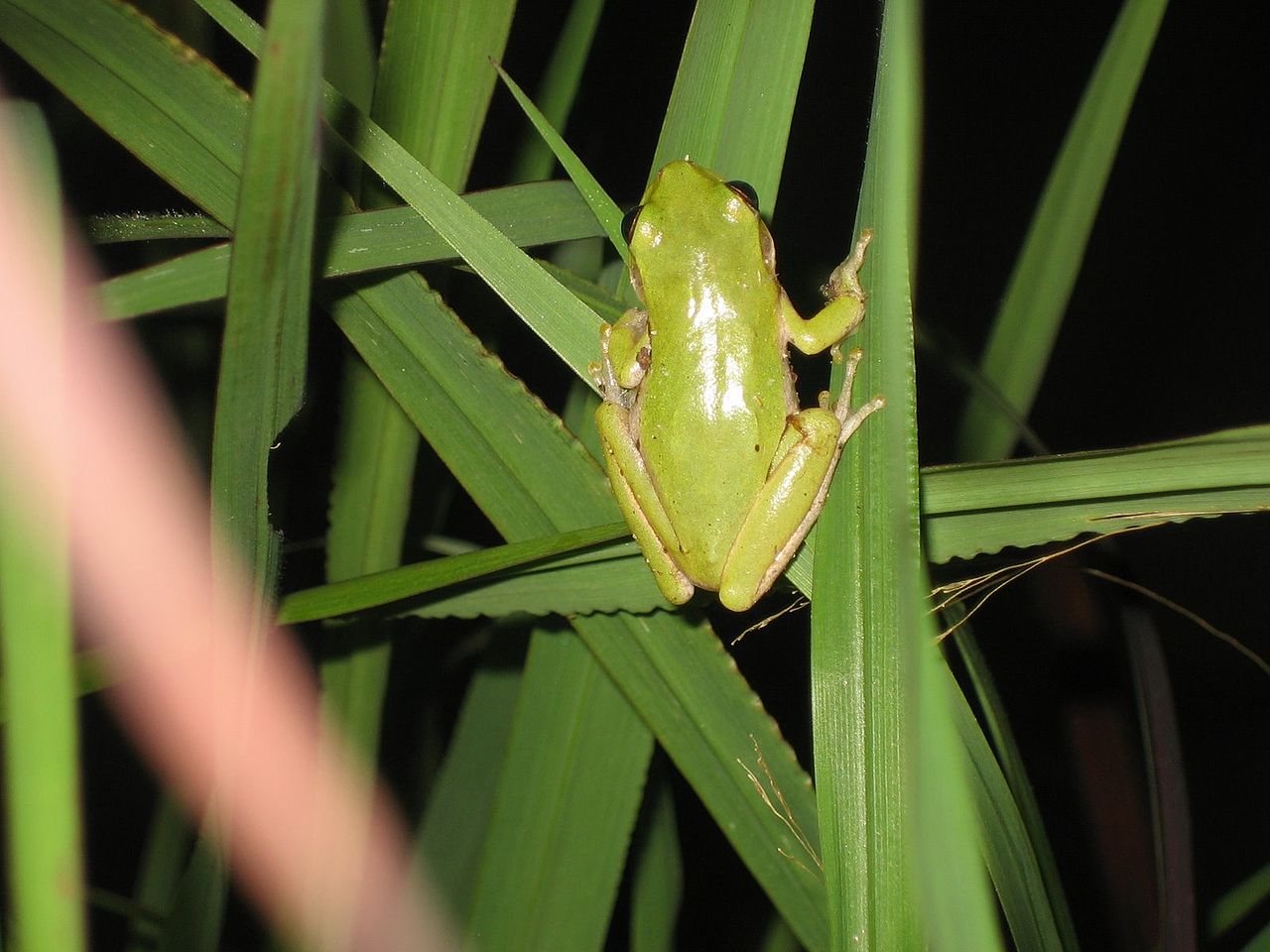
This frog species (Dryophytes squirellus) is named after its call. This is a call that sounds like a squirrel and which lasts less than a second.
Squirrel Treefrogs are arboreal and they grow to an average size of 1.5 inches.
The plain green color is mostly specific to this species. These frogs also come in other colors such as brown and yellow.
A green and black Squirrel Treefrog has also been identified in other states such as Florida.
Tadpoles of this species feed on scrapped vegetation on rocks in the water.
Adults feed on insects.
A decreasing number of species in other states, the Squirrel Treefrog is found in high numbers in Georgia.
4. American Bullfrog

A low-pitched loud belly-like call is specific to the American Bullfrog (Lithobates catesbeianus). This is a room-room call that is considered the loudest call of all frogs in the state.
Small differences in this call have been identified for the American Bullfrog. The species is believed to have 3 types of calls.
Apart from its loudness and its low-pitched call, you can identify American Bullfrogs by their plain green color or by a green and brown color.
This is one of the largest species of frogs in the state with some individuals measuring up to 6 inches.
Large size allows the species to eat a wide variety of animals, insects, and bugs.
Even mice and bats have been eaten by these frogs.
Most American Bullfrogs are found around large water bodies such as ponds and lakes. The species doesn’t like temporary bodies of water.
5. Green Frog

Green Frogs (Lithobates clamitans) have a base green color. Only the head of the species is completely green as the rest of the body is green and brown.
The call of Green Frogs is deep, almost resembling the stomach sounds of cows. The grunt, grunt call of this species is low-pitched. Pauses of a few seconds between the calls are also distinguishable.
Green Frogs live in almost any wet habitat across the state.
High levels of male-to-male aggression are noted for the species.
This aggression is characterized by a higher call frequency and by close physical contact.
Wrestling is specific to males of the species.
6. Southern Leopard Frog
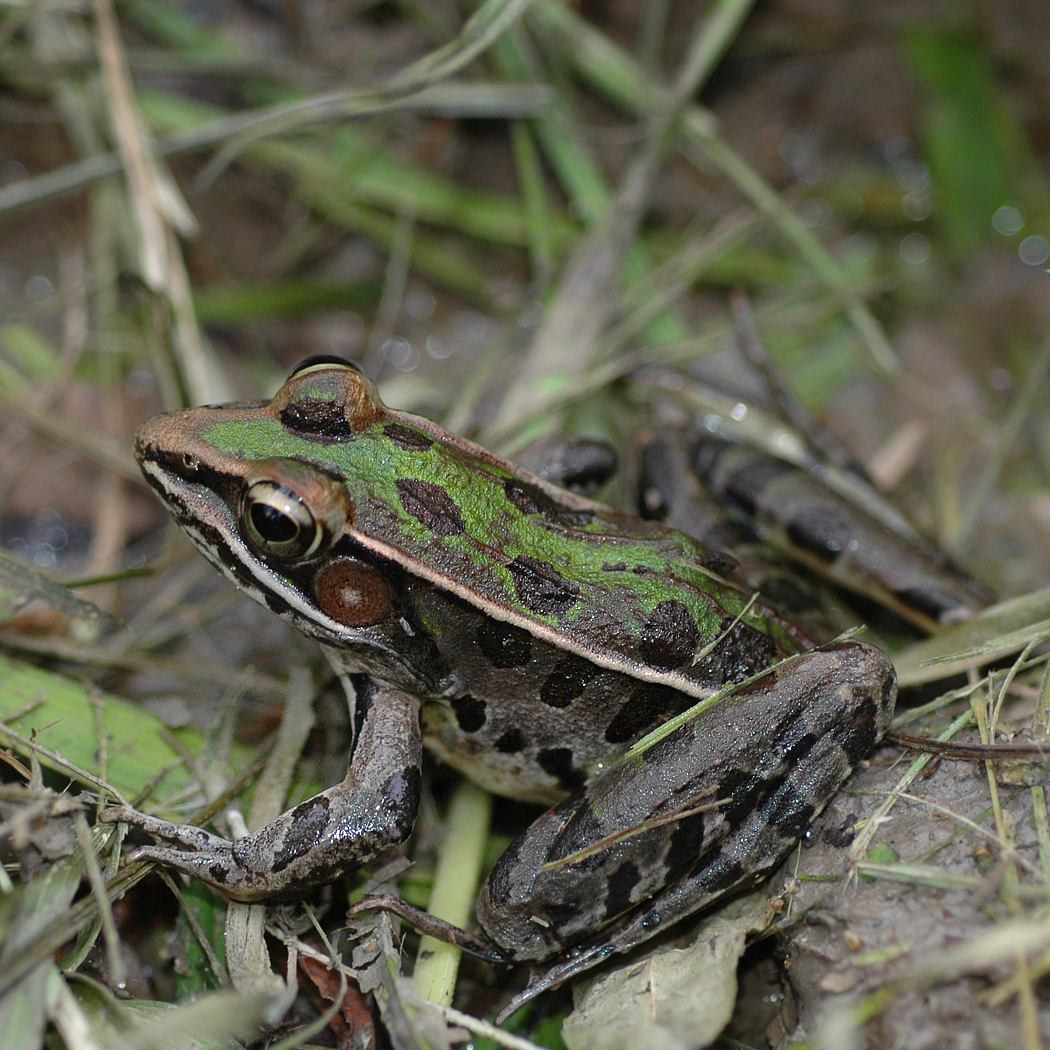
Brown or green base colors are seen on Southern Leopard Frogs (Lithobates sphenocephalus). This is a species that also shows dark brown or black spots on the back.
A specific lateral yellow stripe is also seen dorsally on this species.
Almost all shallow bodies of water can be suitable habitats for this species.
Southern Leopard Frogs have a squeak, squeak call which resembles the sounds balloons make when touched.
These frogs also have a different diet in Georgia as opposed to those in Northern states which eat spiders and beetles.
Southern Leopard Frogs eat crayfish, as they share the same fresh clean waters. They also consume insects.
Southern Leopard Frogs are mainly nocturnal but they are also active during the day when it rains.
7. Southern Cricket Frog

Southern Cricket Frogs (Acris gryllus) are only found in Southeastern parts of the US, including Georgia.
This species has a green and brown color with warts covering its dorsal skin.
There’s a bright central dorsal stripe on the species as well. It can have a bright green or a bright orange color
Only seen during the summer months, Southern Cricket Frogs have a gick, gick, gick call.
This call has a fast pace and can be heard in swamps and ponds of open areas with plenty of direct sunlight.
Southern Cricket Frogs aren’t found on trees or in woodlands as they can’t climb.
Wetland spiders and insects such as mosquitoes make up the bulk of the Southern Cricket Frog’s diet.
Female Southern Cricket Frogs lay hundreds of eggs after mating, but still fewer eggs than other species.
They typically lay between 100 and 150 eggs.
8. Northern Cricket Frog

Northern Cricket Frogs (Acris crepitans) are some of the smallest frogs and smallest vertebrates in the state.
They can be as small as 0.7 inches and may sometimes reach sizes of a maximum of 1.5 inches.
This is a species known for its high-pitched pebble-like sound. Clink, clink sounds that resemble pebbles hitting each other are heard during the mating season of the species.
Northern Cricket Frogs are hylid, categorized as tree frogs. While the species is technically arboreal, it cannot climb.
Its days are spent on the ground, next to the water.
This species comes in green, gray, and brown colors that are patterned.
You can find these frogs around water during the day as Northern Cricket Frogs are diurnal.
9. Pickerel Frog

Coastal plains with warmer waters are preferred by Pickerel Frogs (Lithobates palustris).
This species makes its appearance in April and it remains active until October.
Pickerel Frogs are among the trogloxene species of Georgia. This is a categorization of species that visit caves periodically.
These frogs move into caves for hibernation but they cannot reproduce in caves so they need to come out in the spring.
Known for a body covered in square-shaped blotches, this is a species that can also move into the water during the winter.
It might also call from water.
You can identify the call of Pickerel Frogs by their low-pitched nature. A trill, trill call sound is specific to the species.
Ants, insects, and spiders are routinely eaten by these frogs.
10. Spring Peeper

Spring Peppers (Pseudacris crucifer) are some of the smallest frogs in the state.
They can reach the size of up to 1.5 inches but are often smaller than 1 inch.
As a climbing species, Spring Peepers can make a quick escape when spotting predators.
This species is mostly nocturnal, preferring to hide during the day.
Spring Peppers have a distinct call heard in the spring. This call resembles a bird chirping.
The frequency of the call is one of the important elements females take into account when choosing a male partner.
Spring Peppers feed on insects and can be identified by their distinct coloring.
Tan and brown nuances are mostly specific to this species. Dark brown cross-shaped patterns are also distinguished dorsally.
11. Upland Chorus Frog
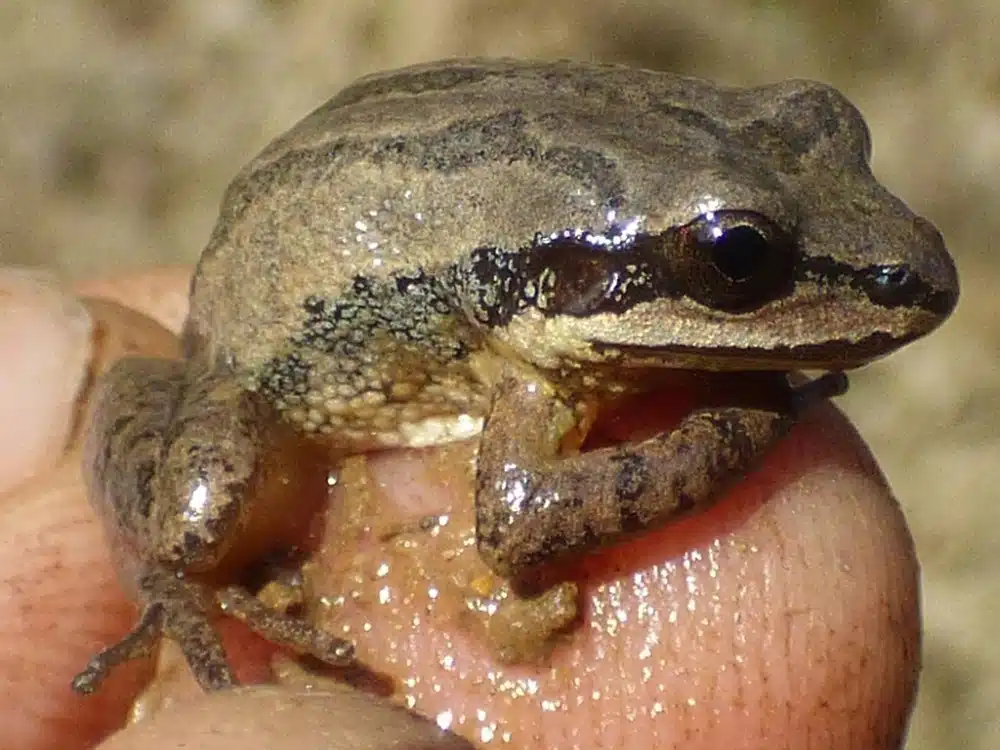
Some of the most secretive frogs in Georgia are Upland Chorus Frogs (Pseudacris feriarum). These nocturnal frogs hide in the ground in moist areas.
The species has similar sizing to other small Georgia frogs. It can be as small as 0.7 inches with only the largest frogs of the species reaching sizes of over 1 inch.
Mostly found in moist lands in valleys, Upland Chorus Frogs have a very distinct call that may not even seem like the call of a frog.
The call marks the beginning of the mating process.
Female Upland Chorus Frogs only lay a small number of eggs after mating. Up to 60 eggs are laid in water, preferably in ponds with plenty of vegetation.
A fast-paced repetitive chirp, chirp sound makes the call of the species resemble bird sounds at night.
A striped green body with contrasting gray or brown patterns is specific to these frogs.
12. Barking Treefrog

Barking Treefrogs (Hyla gratiosa) are named after their barking-like call. This is a muted or low-pitched type of call which is repetitive with pauses of around half of a second.
Barking Treefrogs are only found in Georgia and a few other limited Southeastern habitats.
This small species is identified by its dog barking-like call and its green color.
Rarely brown, this climbing frog also has yellow nuances around its legs.
The species is one of the larger frogs in the state. Even the smallest Barking Treefrogs measure 2 inches while the largest individuals of the species measure 2.8 inches.
Barking Treefrogs are only spotted around water during the mating period. They prefer to move further away into tall vegetation when not mating.
13. Pine Woods Tree Frog

Pine Wood Tree Frogs (Hyla femoralis) are also known as Morse Code Frogs due to a distinct repetitive beeping call.
The size of the species varies between 0.9 and 1.5 inches.
Its coloring also varies considerably. The species has a gray-brown and gray-green patterned coloring.
Coastal areas attract Pine Wood Tree Frogs the most. The species prefers pine woodlands in coastal areas.
Mixed woodlands are also a suitable home for Pine Wood Tree Frogs. This species also lives in pine and oak woodlands.
The species seek out shallow waters to mate and lay eggs in.
Female Pine Wood Tree Frogs are among the species that lay the most eggs. Up to 2.000 eggs can be laid at once after mating.
14. Eastern Spadefoot

Eastern Spadefood frogs (Scaphiopus holbrookii) are some of the darkest in the state. While they can be green, these frogs may also come in a mostly dark green to black color.
This species is known for stereotypical waah, waah calls which are always low-pitched.
Growing to a size between 1 and 2 inches, Eastern Spadefoot is one of the medium-sized species of the state.
These frogs are both diurnal and nocturnal, with a preference for diurnal activities.
It’s during the day that the Eastern Spadefoot feeds on insects and spiders.
Eastern Spadefoot frogs are seen laying hundreds of eggs directly in water. These eggs are only laid in thick vegetation in shallow waters.
Emerging Eastern Spadefoot tadpoles have higher cannibalism rates compared to the tadpoles of other species.
15. Greenhouse Frog

Greenhouse Frogs (Eleutherodactylus planirostris) are some of the smallest species in Georgia.
It might be just one of the few species which can be smaller than the 0.7-inch measurement specific to the smallest frogs in Georgia.
Some of the smallest Greenhouse Frogs in the state measure just 0.6 inches with some larger individuals reaching a size of up to 1 inch.
This species comes in 2 morphs. A mottled and a striped morph are specific to the species
Greenhouse Frogs have been introduced to Florida from Cuba. They expanded their reach to Georgia afterward.
Greenhouse Frogs are very small but can still be heard calling.
A chirp, chirp call is specific to this species which can be confused with the sound of nearby birds.
Since these frogs are introduced, they also have different mating habits.
For example, Female Greenhouse frogs lay eggs in sacs on dry land and not in the water as other frogs in Georgia.
16. Pig Frog

The call which resembles the pig grunt names this frog species (Lithobates grylio).
The green color is specific to these frogs dorsally while yellow is their main ventral color.
If Greenhouse Frogs are some of the smallest frogs in Georgia, Pig Frogs are some of the largest.
These are the species that may reach a size of up to 6 inches but most measure around 4-5 inches.
A large body allows these frogs that look like toads to eat fish and crayfish.
Insects are also consumed by Pig Frogs which tend to eat anything they can easily swallow.
Larger females are also known to lay a vast amount of eggs after mating. Thousands of eggs are laid by the mated Pig Frog female.
Nocturnal by nature, Pig Frogs are highly active in humid areas with dense vegetation.
17. Cuban Tree Frog

These frogs (Osteopilus septentrionalis) are also introduced to Southeastern US territories, including Georgia.
Frogs of this family have wide color variation and may not resemble the species in its different morphs.
Grey Cuban Tree Frogs are just as common as Green Cuban Tree Frogs. These are species also seen in a brown base color.
These frogs have adapted their colors to the colors of the ecosystem.
A gray to white morph of Cuban Tree Frogs is also seen in coastal areas, albeit to a lesser extent than in Florida.
The call of this species is a slow waak, waaak sound which resembles the sound of crows.
Cuban Tree Frogs are an invasive species that tends to draw out native frog species around the state.
A diminishing number of frogs is reported in areas with Cuban Tree Frogs.
Some locals may kill it when spotted as a result.
18. Little Grass Frog

Little Grass Frogs (Pseudacris ocularis) are among the smallest frogs in Georgia.
This frog is so small it can sometimes be spotted on the tips of grass stems.
The small size of the species allows these frogs to move away from a dangerous situation quickly.
They can escape humans, snakes, and raccoons simply by jumping a few times since they cover distances tens of times longer than the size of their body in a single jump.
Even the largest Little Grass Frogs only measure 0.7 inches.
These are some of the most overlooked species by predators as they are small and colored in the colors of their habitat.
A chirp-like call is specific to this species. Unlike other calls, the call of Little Grass Frogs has 2 parts. A chirping sound is heard first, followed by a string of trill sounds afterward.
19. Bird-voiced Treefrog

Bird-voiced Treefrogs (Hyla avivoca) have dual coloring and distinct calling sounds.
This is a species that has a light gray base coloring with dark gray mottling. A wide central dorsal section of the species has bright green coloring.
Bird-voiced Treefrogs are among the species which use only a section of their body for camouflaging colors.
This species has a rapid call. A wit, wit whistling-like sound that resembles the singing of birds is characteristic of their call.
Bird-voiced Treefrogs are found in woodlands, especially those next to the water.
Mixed woodlands, pine woodlands, cypress, and birch woodlands tend to attract Bird-voiced Treefrogs.
Temporary bodies of water such as ponds in the spring around these woodlands also attract the species.
20. Wood Frog

Wood Frogs (Lithobates sylvaticus) are a species seen in a wide variety of colors and patterns.
This species can be brown, red-brown, gray, dark gray, green, and tan. It can show warts on the skin or it may have plain skin.
Wood Frogs grow to an average size of 2 inches and are one of the specie of Georgia impacted by migration.
A common sight across woodlands in the summer, Wood Frogs prefer to move upland for the winter months.
Overwintering is an important process in the life of these frogs which survive even in freezing temperatures as their organs can freeze as well.
A repetitive call sound ca-hac, ca-hac is specific to these frogs.
Females respond to these calls and come out of the water.
The female of the species spends all day underwater to avoid males and only comes out to mate occasionally.
The female Wood Frog then deposits eggs and attaches them to submerged vegetation.
21. Ornate Chorus Frog

Ornate Chorus Frogs (Pseudacris ornata) come in gray, red, red-brown, and green colors.
They have dark brown, dark gray, or black patterns on their legs and their size. This is a species named after its decorations or patterns on its sides.
The call of the species is very distinct from other calls. A string of 3-4 calls is heard in the species.
Calls heard initially are trill, trill chirp-like calls while the last call of a string represents short tik-tak sounds.
While the species can be widespread around woodlands, it has a short lifespan. Many frogs of the species don’t survive more than 2 years.
22. River Frog
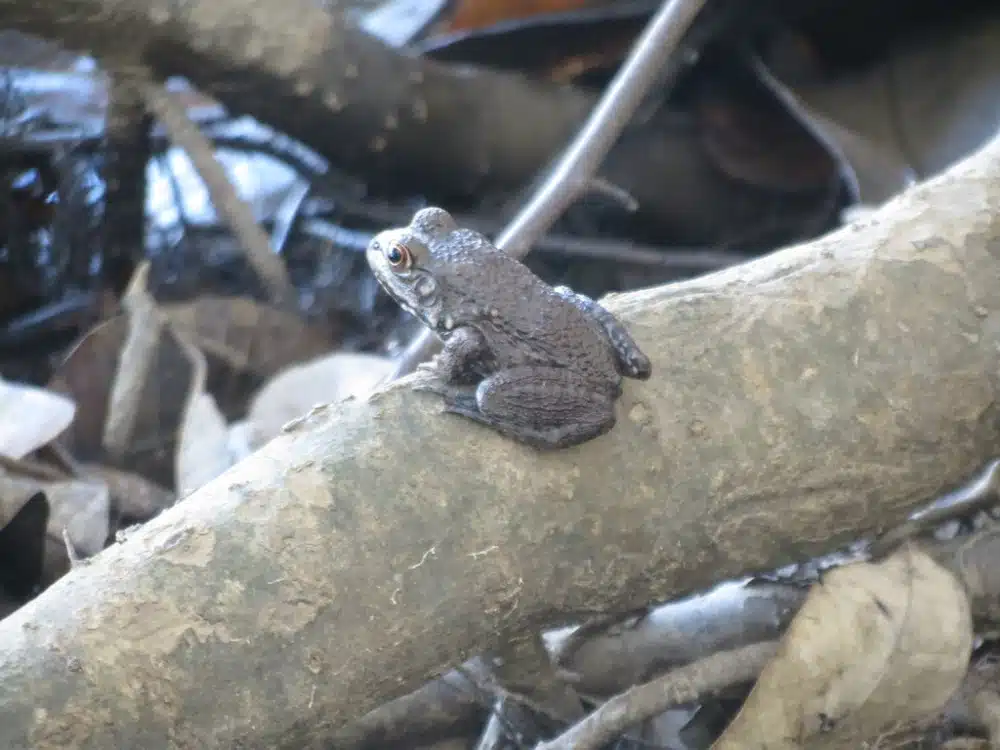
River Frogs (Lithobates heckscheri) are some of the largest species found around permanent water sources such as streams, rivers, and ponds.
This is also one of the largest frogs possibly found in Georgia with a maximum size of 5 inches.
Their size also impacts the deep call. River Frogs have a call that resembles snoring but is low-pitched, specific to larger frogs in tonality.
23. Southern Chorus Frog
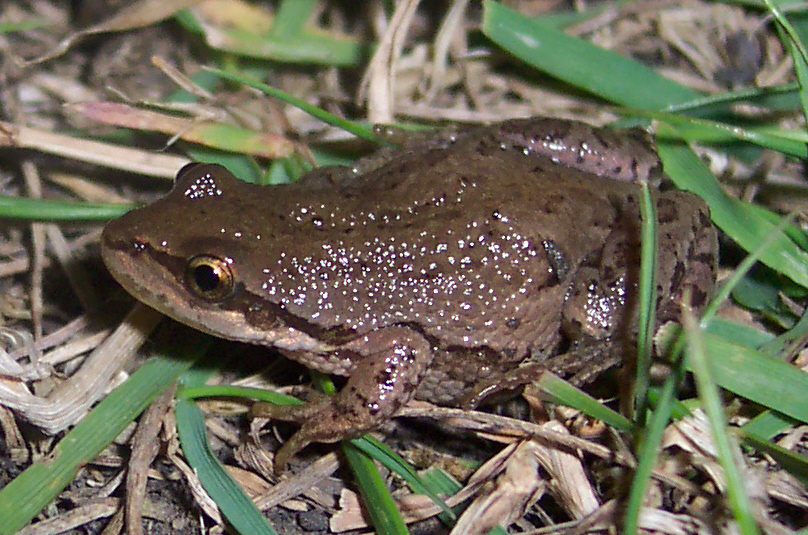
Southern Chorus Frogs (Pseudacris nigrita) are only found in Georgia and neighboring states.
This is a species that comes in gray and green colors and which inhabits both woodlands and grasslands.
The call of the species has 2 parts.
A trill, trill sound is heard with the call. The first part is louder while the second part is the same but at a lower tone.
24. Collinses’ Mountain Chorus Frog
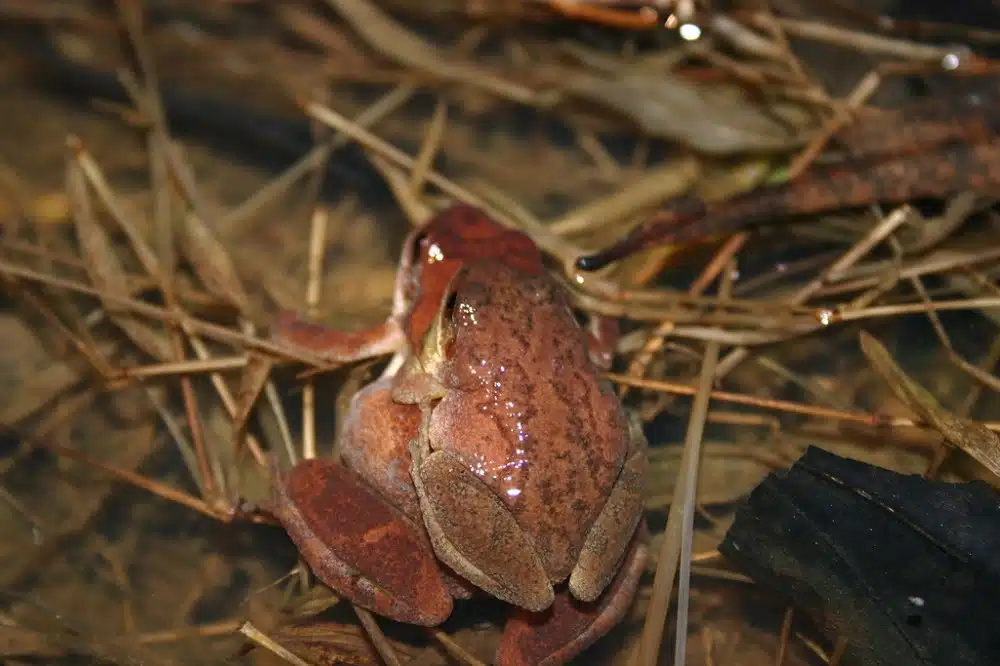
Woodlands with temporary bodies of water represent the ideal habitat of Collinses’ Mountain Chorus Frogs (Pseudacris collinsorum).
A species that lives at medium to high elevation, these frogs are seen in different colors.
Their green or gray colors may show stripes and interrupted stripes but they can also be plain colors.
Frogs of this genus have a short call that resembles the sound of listening to a pulse through a stethoscope.
25. Gopher Frog
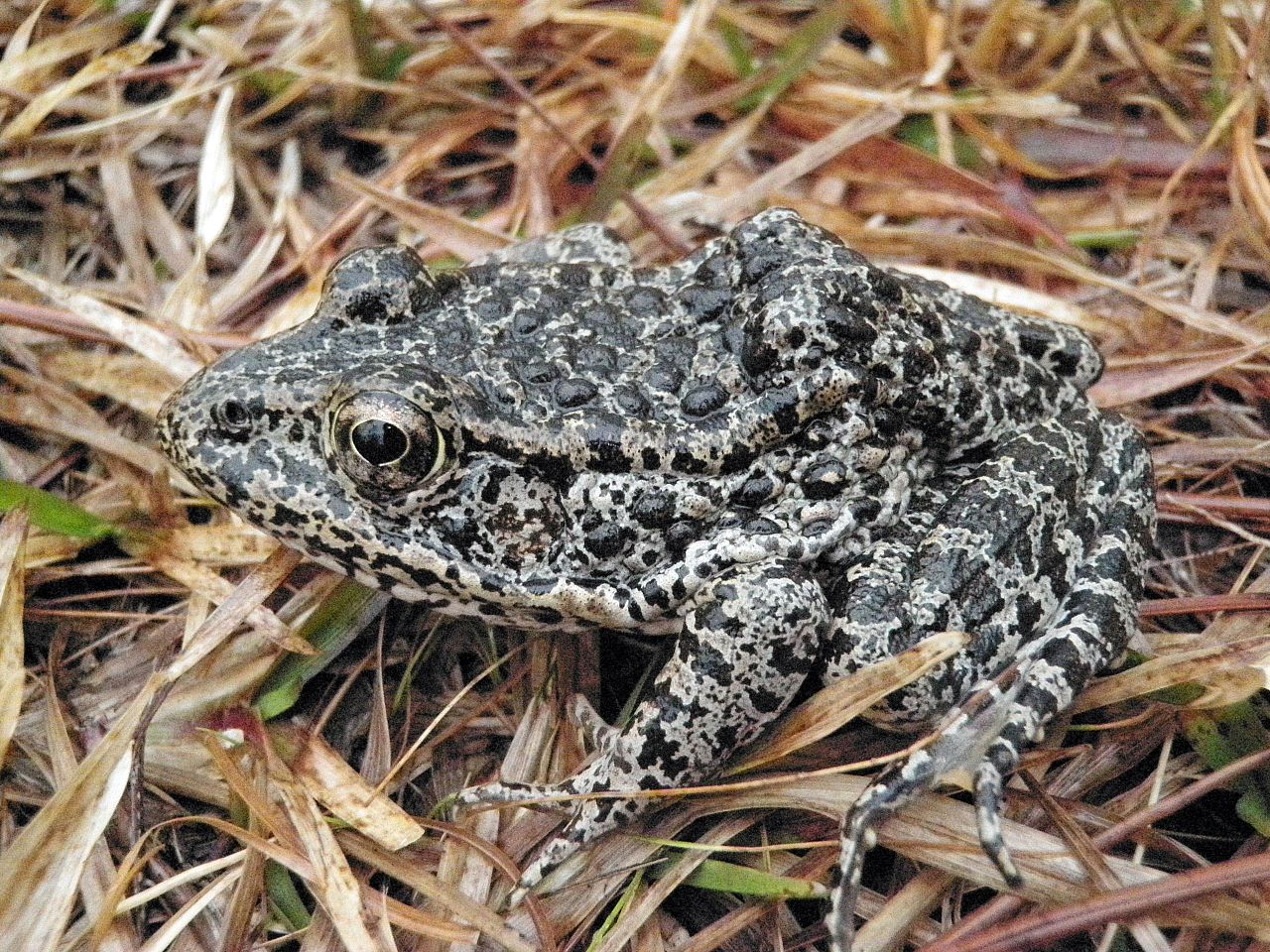
Gopher Frogs (Lithobates capito) are some of the rarest types of frogs in Georgia.
Low tolerance to habitat changes is one of the reasons this species is rarely seen.
A dark-colored species, Gopher Frogs are only found in temporary bodies of water in woodlands.
The call of the species is low-pitched and it resembles the sound of snoring.
26. Carpenter Frog
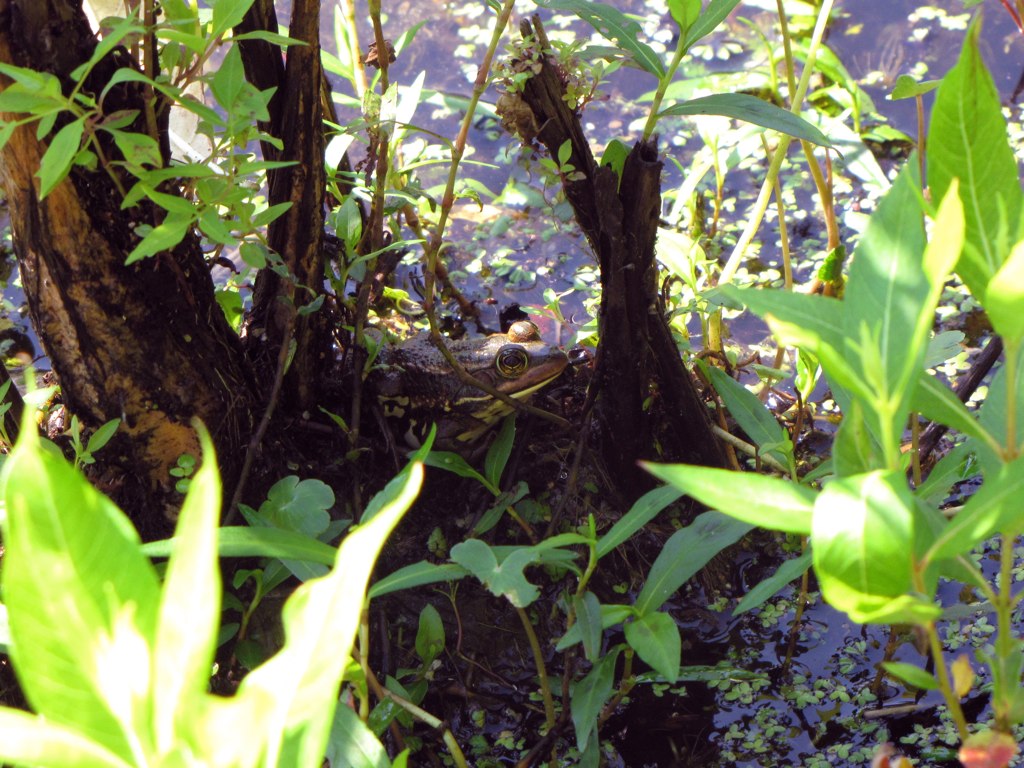
Carpenter Frogs (Lithobates virgatipes) are among the few species in the state that only live in water.
Acidic water high in different vegetation species attracts these frogs the most.
Having a gray and black color and living in water, these frogs are difficult to find and spot.
They have either a low-pitched or a high-pitched call, depending on their size.
A pah-tan, pah-tan call is specific to these frogs.
27. Brimley’s Chorus Frog
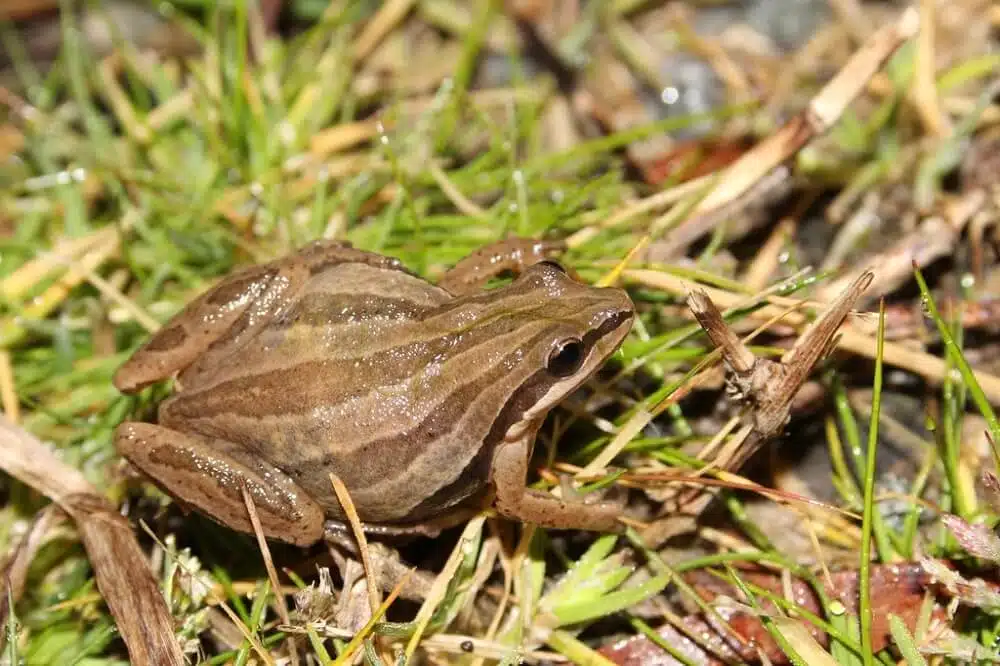
This rare species (Pseudacris brimleyi) is normally only found in subtropical climates.
It might also be seen in Georgia in its gray or green morph.
Black stripes run along its body and the eyes.
Frogs of this family have a 2-part call that resembles singing bird sounds. The trill-trill call is softer in its second part.
28. American Toad

American Toads (Anaxyrus americanus) are some of the most common species across Georgia.
The state is home to Eastern American Toads, a species known for high color variation among females compared to males.
Green, brown, and even black colors with or without patterns and warts are seen on the female American Toad.
This is a species that grows to a size between 2 and 3 inches.
The reduced size of the toad might sometimes confuse the species with Fowler’s Toads and other smaller toads.
When it comes to the call of the species, it’s often compared to a telephone or an alarm sound.
A tring-tring repetitive sound can be heard in cycles of up to 1 minute.
29. Southern Toad

A short trill, trill call is specific to the common Southern Toad (Anaxyrus terrestris).
This is a species found in high numbers in Georgia and in lesser numbers in other states where invasive Cane Toads drive it out of its natural habitat.
Southern Toads grow to an average size of 3 inches. This is a species that can be seen as one of the most highly active nocturnal toads in the state.
It often ends up around homes, attracted to lights and insects.
The Southern Toad is also a common sight on farms, on active or abandoned crops.
Swamps, ditches, and any other temporary humidity areas attract these toads in high numbers.
30. Fowler’s Toad

One of the longest calls among Georgian toads is tied to this species (Anaxyrus fowleri).
Fowler’s Toads have a long waaah, waaah low-pitched call which lasts seconds. There’s a short break between these calls as well.
Fowler’s Toads are sometimes confused with American Toads.
However, this species comes in different colors. Brown and green colors are specific to the species.
It also comes in an orange-red morph and it may show white or black patterns as well.
Fowler’s Toads are known to have varying sizing. They can grow up to a maximum size of 3.7 inches.
31. Eastern Narrow-mouthed Toad

A long weeeee call is specific to the Eastern Narrow-mouthed Toad (Gastrophryne carolinensis).
This is a high-pitched call specific to smaller toads. Eastern Narrow-mouthed Toads are smaller than Fowler’s Toads.
They grow to a maximum size of 2.1 inches compared to the double maximum size of Fowler’s Toads.
Swamps around woodlands are some of the most common habitats of this species.
It can be found around pine woodlands, cypress swamps, coastal woodlands, and even in humid sandy terrains.
They rely on water sources to live in, mate in, and even lay eggs in.
Male Eastern Narrow-mouthed Toads call both from water and dry land.
32. Oak Toad

Oak woodlands in the Eastern part of Georgia are ideal habitats for Oak Toads (Anaxyrus quercicus).
A long chirping call is specific to the species.
Oak Toads are a small species that only reach a maximum size of 1.3 inches. These toads have a bright central dorsal stripe which contrasts their dark coloring.
Small coloring differences are noted between the male and the female Oak Toad.
A small species that resemble frogs, this toad has different ventral coloring between males and females.
Male Oak Toads have a plain white ventral color while females have a white ventral color with black mottling.
Maritime forests, sandy areas around woodlands, and savannahs are the habitats of this toad.